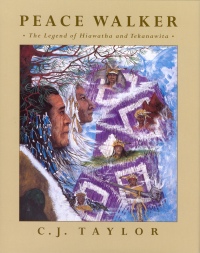| ________________
CM . . .
. Volume XI Number 6 . . . .November 12, 2004
excerpt:
C.J. Taylor's beautifully illustrated and vividly written interpretation of the Iroquois legend of Hiawatha and Tekanawita is destined to become a classroom and library favorite. The legend recounts a time when the Five Nations of the Iroquois Confederacy despaired under an evil chief named Atotarho. There was no respite from his cruelty; his spies were well placed to report any voices that spoke ill of his reign and all were deathly afraid. Among the people, only the powerful chief Hiawatha, a former friend but now a determined foe of Atotarho, refused to do his bidding. The people of Hiawatha's tribe were so afraid of Atotharo's wrath that they had a powerful shaman drive Hiawatha mad and into the wilderness. Alone in the forest, he had visions of a time of peace and spoke to many tribes but was shunned by all the Iroquois peoples. The Huron people, who lived north of the Iroquois, also suffered under the brutality of Atotarho. There, the people shunned a young man named Tekanawita. During her pregnancy, Tekanawita's mother had a dream that her child would travel south and meet a great man. Together, they would unite all peoples against the evil chief and bring peace to the land. When the two outcasts met, they recognized their mutual destinies and worked tirelessly to unite the suffering people. After many years of fruitless pleading, the people finally agreed to challenge the evil chief. Tekanawita composed a peace song and led the people to face Atotarho. When faced with the combined determination of all the Iroquois, Atotarho was transformed into a giant pine tree. The people were reunited in peace, and the chosen leaders of the five tribes would meet under the tree to deliberate and work for the benefit of all their people. Students of all ages will shudder at the description of Atotarho: "Live snakes wriggled in and out of his gray hair and slithered up and down his scaly arms. His orange eyes could pierce the soul of a man...." They will be moved by the heartless way the two protagonists were treated by their craven tribesmen, and they will be entranced by the story's dramatic tension. This legend could be put to marvelous use in Canadian history courses as well. It provides a marvelous opportunity to reflect upon the achievements of the First Peoples original forms of self-governance. It also brings to mind the nature of democratic virtues and each individual's responsibility toward our free society. Highly Recommended. Ian Stewart teaches at David Livingstone School in Winnipeg, MB.
To comment
on this title or this review, send mail to cm@umanitoba.ca.
Copyright © the Manitoba Library Association. Reproduction for personal
use is permitted only if this copyright notice is maintained. Any
other reproduction is prohibited without permission.
NEXT REVIEW |
TABLE OF CONTENTS FOR THIS ISSUE
- November 12, 2004.
AUTHORS |
TITLES |
MEDIA REVIEWS |
PROFILES |
BACK ISSUES |
SEARCH |
CMARCHIVE |
HOME |
